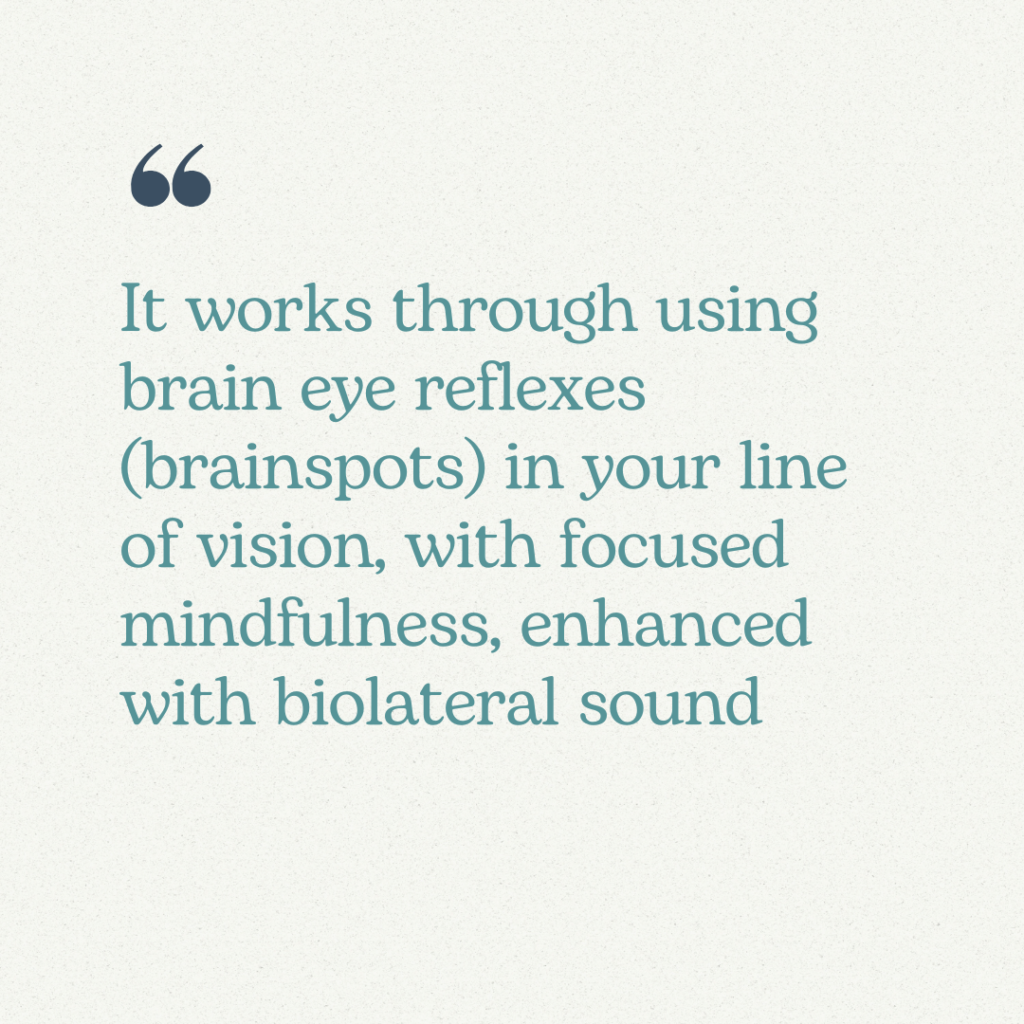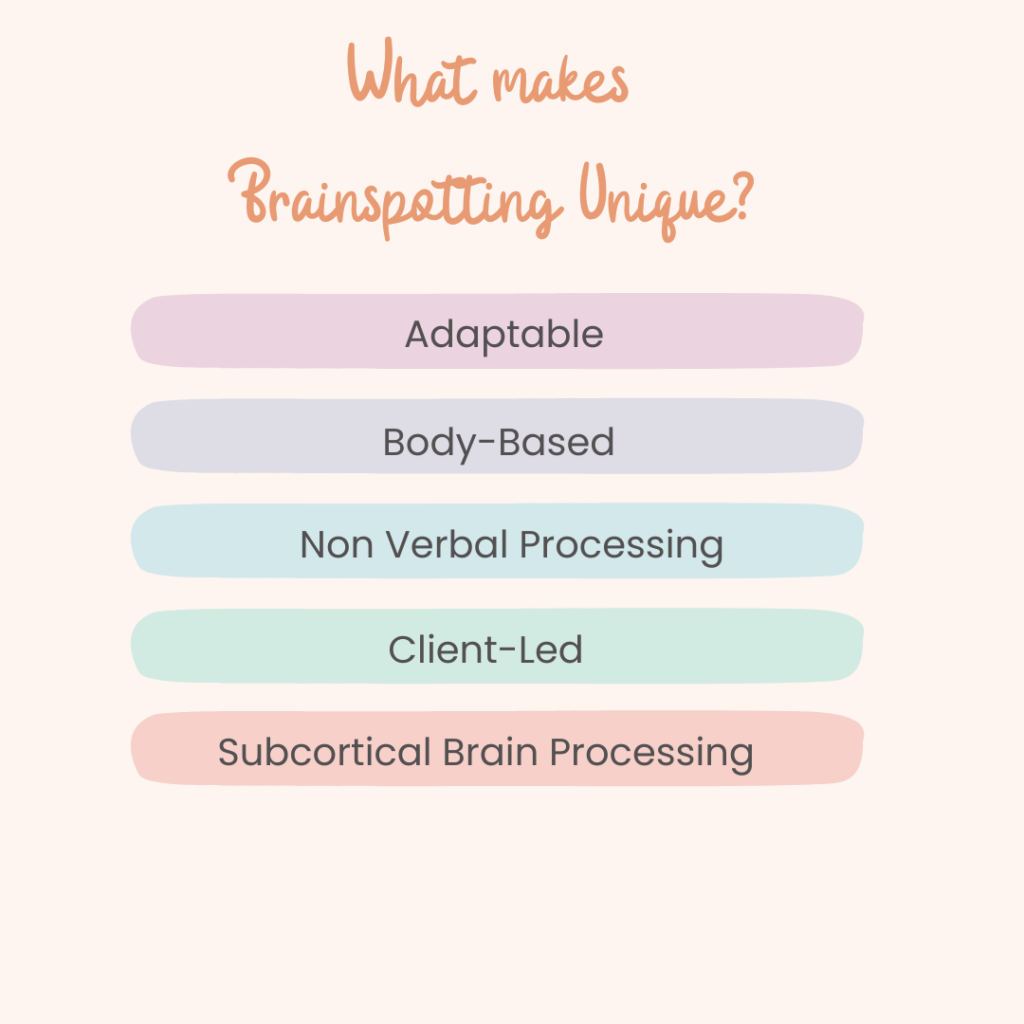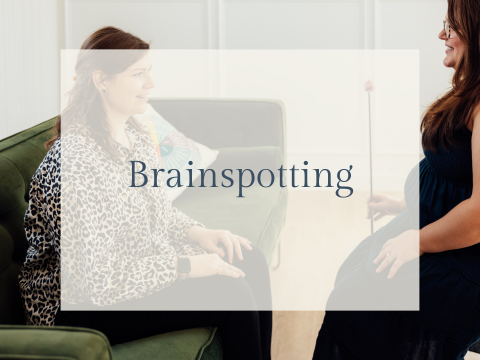Angela Prior
lcsw, ryt, ciec
hey there!
The AP blog is here for all things mental health, embodiment, yoga, and burnout. Poke around and take what you need.
meet angela
Brainspotting and it’s role as a Trauma Therapy
May 27, 2025
In the realm of therapy and trauma treatment there are various approaches that offer pathways to healing and growth. One relatively newer, yet increasingly recognized, method is Brainspotting (BSP). Developed by Dr. David Grand in 2003, Brainspotting is a powerful and focused treatment method that works by identifying, processing and releasing core neurophysiological sources of emotional/body pain, trauma, dissociation and a variety of other challenging symptoms.
What is Brainspotting?

At its core, Brainspotting is a brain-body based therapy that utilizes specific points in your visual field to access unprocessed trauma and emotions held deep within the brain, particularly in the subcortical regions – areas responsible for emotions, body sensations, and survival responses. The fundamental principle behind Brainspotting is that “where you look affects how you feel.” Think of these brainspot acting as an access point to your deeper brain functions such as your limbic system (where fight, flight are) and these access points can be used to help with reprocessing of experiences and beliefs.
How Does Brainspotting Work?
It works through using brain eye reflexes (brainspots) in your line of vision, with focused mindfulness, enhanced with biolateral sound to identify, process and release sources of emotional/body pain, trauma, dissociation and a variety of other challenging symptoms.
- Scanning the visual field to locate a “brainspot” which is a brain eye reflex
- Using your eyes to focus on the identified brainspot the therapist has “bookmarked” with a teachers pointer
- Finding awareness to your bodily sensations
- Processing negative emotions
- Stimulating memories, thoughts, and viewpoints
- There are a variety of set ups and frameworks based on the individual clients needs and response to brainspotting.
During a Brainspotting session, a trained therapist will work with you to identify these relevant eye positions. This is often done by:
- Identifying a Focus: You and your therapist will identify a specific issue, memory, or feeling you want to work on.
- Body Awareness: You’ll be encouraged to notice where you feel this issue in your body – any sensations, tension, or discomfort.
- Eye Positioning: The therapist will often use a pointer, moving it slowly across your visual field. You’ll be asked to pay attention to any shifts in your body sensations or emotional intensity as your eyes follow the pointer.
- Locating the “Brainspot”: A “brainspot” is the eye position where you experience the most intense activation of the feeling or body sensation related to the focus issue. This spot is believed to directly connect to the neural network holding the unprocessed experience.
- Sustained Focus: Once a brainspot is identified, you will be asked to hold your gaze on that specific point. This sustained attention, while staying present with your internal experience, allows the brain to begin to process and release the stored emotions and trauma.
- Dual Attunement: Throughout the process, the therapist maintains a state of “dual attunement,” paying close attention to both your verbal and non-verbal cues while also being attuned to their own internal experience. This creates a safe and supportive therapeutic relationship.
- Processing: While your gaze remains on the brainspot, you may experience a range of thoughts, feelings, memories, and body sensations. The therapist will hold space for this process, offering support and guidance as needed, without necessarily directing the content. The idea is to allow your brain’s natural healing mechanisms to unfold.

What Makes Brainspotting Unique?
- Brainspotting is Adaptable: It was developed to allow therapists to be flexible with their approach to find the right iteration for each client.
- Body-Based: Brainspotting recognizes the deep connection between the mind and body in storing and processing trauma.
- Less Reliance on Verbal Processing: While talking can be part of the process, Brainspotting often allows for deep processing without the need to extensively re-tell traumatic stories and clients can talk as much or as little as they would like.
- Accessing Deeper Brain Regions: It’s believed that Brainspotting can access deeper, subcortical areas of the brain where trauma and emotions are often held outside of conscious awareness. It is believed to help access the deeper causes that influence impulsivity, inattention, or hyperactivity.
- Client-Led: The process is largely guided by the client’s internal experience and the sensations that arise.
What Can Brainspotting Help With?
While research is ongoing, Brainspotting has shown promise in addressing a wide range of issues, including:
- Trauma and PTSD
- Anxiety and panic disorders
- Depression
- Grief and loss
- Phobias
- Performance enhancement
- Chronic pain
- Attachment issues
- And more
With all things therapy the modality is simply the vehicle that you are using to get you to where you want to go. All vehicles will get you somewhere the time frame, the ride, and the overall experience may differ. Brainspotting is like any other modality; it is a vehicle that may take you to where you want to go.


eight free meditations
To Support Your Mental Health
Let's Work Together
Meet Our Team of Therapists + Yoga Instructors